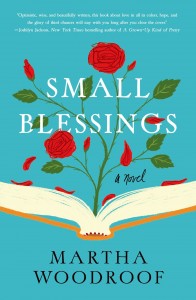The novels of Nicole Mones
Overheard in the bookstore the other day:
“Have you read this? It’s wonderful.”
“I don’t read novels, when I read I want to learn and educate myself.”
I’ve heard variations on this opinion before from smart and respectable non-fiction-only readers and I always nod and smile. In truth, however, I have to quell the urge to grab them by the arm, march them into a comfortable chair, give them a cup of coffee and demand they read an author such as Nicole Mones.
A newly launched textile business took Nicole Mones to China for the first time in 1977, after the end of the Cultural Revolution. She traded textiles with China for eighteen years before she turned to writing. Ms. Mones’ extensive knowledge of China’s culture, history and politics is woven throughout her books. Her novels are enthralling, but each one is an education as well. Ms. Mones is an author who obviously understands that there are readers who want to think and be entertained at the same time.
++++++++++++++++++
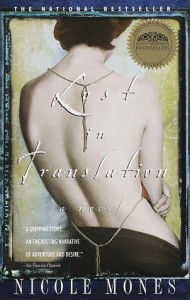 Lost In Translation, Ms. Mones’ debut novel takes the reader into the world of Alice, an unlikeable American woman living in contemporary China. Alienated from her Congressman father because of his overt racism, Alice seeks to leave America behind and become Chinese. She works as a translator by day and secretly haunts bars at night often having one night stands with Chinese men – trying to understand and connect with the xenophobic culture.
Lost In Translation, Ms. Mones’ debut novel takes the reader into the world of Alice, an unlikeable American woman living in contemporary China. Alienated from her Congressman father because of his overt racism, Alice seeks to leave America behind and become Chinese. She works as a translator by day and secretly haunts bars at night often having one night stands with Chinese men – trying to understand and connect with the xenophobic culture.
But things change for Alice when she accepts a translator position with an archeological team tracking the remains of the ancient and important Chinese treasure — “the Peking Man”. Alice becomes close to Lin a member of the team, while they navigate mysterious secret meetings and the threat of arrest. Working with Lin, she forms a close connection and better understanding of Chinese culture and history
The novel not only mesmerizes with the fictional characters and storyline, but goes further to weave in the historical significance of Peking Man as the first ancestor of China and the important writings of the French Jesuit priest-philosopher, Tielhard de Chardin, from whom the archeological team gains clues as to the whereabouts of the bones. This novel has it all – an engrossing mystery combined with Chinese cultural history and a dash of sex and romance.
The title* captures the gist of the novel, namely the difficulties of trying to move between cultures, language, history and current society — never being sure what has been lost in translation. (*No relation to the Bill Murray film of the same name.)
+++++++++++++++++++++++
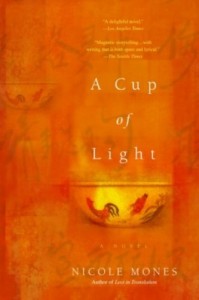 A Cup of Light transports us into the rarefied world of Chinese porcelain “pots” long treasured by emperors and collectors alike.
A Cup of Light transports us into the rarefied world of Chinese porcelain “pots” long treasured by emperors and collectors alike.
Lia Frank is an American appraiser of fine Chinese porcelain and is sent to Beijing to authenticate a collection of rare pots going up for international sale. As she unpacks the crates, holding each delicate piece and “feeling” the refined porcelain, she discovers there are many more pots than originally estimated and that some of them are “fakes”. But these are no ordinary fakes –these are forgeries so exquisite, so precise that she has to find the forger. In Chinese culture when the copy is as beautiful as the piece it imitates then the forgery and the forger are greatly admired.
Again an education here — with A Cup of Light you’ll discover the infamous Chenghua Chinese cups, visit the town of Jingdezhen where the truly priceless pots were manufactured for the emperors and learn how these pots were hidden and smuggled out (with some lost) during the 1931 Japanese invasion. Also, if you’re like me you’ll cringe in embarrassment as you learn that J.P. Morgan (yes that J.P. Morgan) tried to buy the entire contents of the Forbidden City in 1913 for twenty million dollars – so many of the priceless and culturally important pots were buried and hidden. Luckily, old J.P. died and the deal was abandoned.
Lia wears hearing aids and takes them out to achieve complete silence to exercise her memories. Lia is a mnemonist and has memorized not only every pot she has ever examined, but also every catalog and history. She uses the Greek/Roman mnemonic system to memorize and at first I found it unbelievable, but with a little research I found it was actually a real thing. Ms. Mones also based this on the real missionary Matteo Ricci who taught young Chinese scholars tricks to increase their memory skills–an important advantage in a nation with countless laws and rituals which had to be learned by heart. But I digress, when Lia goes into her memory files to help her determine which pot is real or fake, we get some fascinating Chinese porcelain history. Also fascinating is the current day political intrigue intruding into Lia’s world of beautiful pots contrasted with her researching (remembering) similar shadiness throughout the history of Chinese porcelain.
Ms. Mones was a textile trader in China for many years and her knowledge of the underworld of art smuggling and forgeries shines through. In each of her novels, the lead female characters have many flaws, but Ms. Mones always portrays them as competent, professional women with real work to accomplish.
+++++++++++++++++++++++
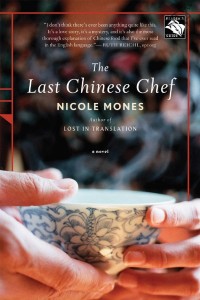 The Last Chinese Chef is probably my favorite of her novels. This time, Ms. Mones, a contributor to the now sadly defunct Gourmet magazine, takes us into the luscious world of Chinese cuisine.
The Last Chinese Chef is probably my favorite of her novels. This time, Ms. Mones, a contributor to the now sadly defunct Gourmet magazine, takes us into the luscious world of Chinese cuisine.
When Maggie McElroy, a widowed American food writer, learns of a Chinese paternity claim against her late husband’s estate, she has to go immediately to Beijing. She asks her magazine for time off, but her editor counters with an assignment: to profile the rising culinary star, Sam Liang, who is about to open an imperial-style restaurant in Beijing. When the restaurant opening is delayed Sam, who is half Chinese, half American, acts as Maggie’s translator and helps her track down the child and unravel the mystery of the parentage.
But readers – it’s the backdrop of the FOOD that is the heart and soul of this novel.
We understand the intricacies of Chinese cuisine. The concepts of texture and appearance are as important as flavor on the Chinese table. We learn about “guanxi” — the Chinese concept of relationships. We see that food is at the heart of Chinese relationships, one reason why all meals are shared in China and never individually plated. Chinese cuisine is very much about presentation including symbols and references which are understood instantly and connect its people not only to one another but to their culture and history.
This is not to say that the characters or the plot of The Last Chinese Chef aren’t compelling — oh they are. Sam, the heir to the family’s cooking expertise, is sexy yet gentle – helping Maggie comprehend the often mystifying Chinese culture and re-awakens her interest in food by preparing her luscious dishes (I know… sigh). Sam decides to enter a Chinese cooking competition and we watch, smell and taste the tapestry of the food he prepares to practice. Sam’s grandfather, Liang Wei, had been one of the last generation of chefs in the Forbidden City and the author of a highly regarded tome on the art of Chinese cuisine. Each chapter of the book starts with quotes of wisdom from this fictional but very realistic Chinese cook book. Eventually, Maggie and Sam unravel the truth behind the child’s parentage, but by then Maggie doesn’t care so much, re-awakened from her grief and happily eating.
+++++++++++++++++++++++
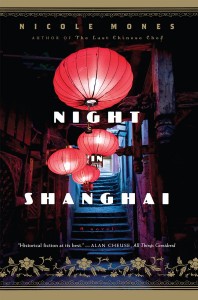 Night in Shanghai is Ms. Mone’s most recent novel. I haven’t read it, but it’s next on my list.
Night in Shanghai is Ms. Mone’s most recent novel. I haven’t read it, but it’s next on my list.
It’s about the little-known story of black musicians in the Chinese jazz age. You can watch the book’s trailer HERE.
(Who knew that one day book publishing/marketing includes film-style trailers.)
Her by Harriet Lane
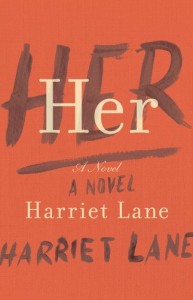 You may remember my review of Harriet Lane’s previous novel Alys Always.
You may remember my review of Harriet Lane’s previous novel Alys Always.
I greatly admire Ms. Lane’s spare and visual writing style –she’s a writer who can paint so much in so few words.
Her is her second novel and like Alys Always it’s creepy minimalist writing at its best.
Told in the first-person narrative from two women’s perspectives, the novel teases you along in alternating chapters.
Nina spots Emma in North London — a woman she knows from her childhood and contrives a way to connect with Emma — we know not why.
Emma is a harried, scattered mother of two kids. She is also vulnerable and clueless – she doesn’t remember Nina and takes her to be a new friend. You cringe as Nina (obviously a psychopath) begins to orchestrate a series of devious and manipulative events to successfully insinuate herself into Emma’s life.
Emma’s messy, but ordinary domestic life is the perfect stage for Nina to play out her menacing plan. True friends – maybe not. Nina purposely messes with Emma — household items go missing, babysitting plans go awry, a child seems to get temporarily lost — these haphazard domestic incidents provide a ominous backdrop. The reader knows this is a household about to unravel in a most disturbing way.
And so we are intrigued…what’s going to happen? Why is Nina so intent on connecting with Emma? What was the past incident that is causing this evil charade?
As in her previous novel, Ms. Lane is very good at painting the seemingly normal, but creepy stalker. Slightly “off” people who seamlessly infiltrate themselves into innocent lives. You read along, nervously aware that something terrible is going to come of all this, but unsure what, how or why. That is the mark of an intelligently constructed thriller.
This book has been compared to the currently popular thrillers Gone Girl and Girl on a Train. I’ve read both books and Her is far superior writing and I think more thrilling and creepy. Again, it’s the minimalist writing – an around-the-campfire ghost story teller who pauses for utmost effect to let your imagination fill in around the silence.
My only quibble is with the reiteration of the same event from each woman’s point of view — there isn’t enough difference in the two voices to make the re-telling fresh and so at times the narrative seems to slow down – but perhaps this is Ms. Lane’s intention – maybe it’s supposed to be a slow burn.
Stick with it my friends, the author kicks up the tension and the last chapters are evil and frightening. To some, the ending may feel unfinished and you may be wondering WHY? — but that is the chilling nightmare.
A Paris Apartment by Michelle Gable
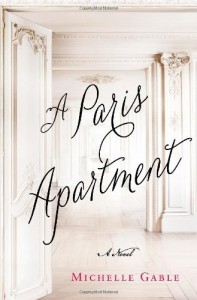 Remember THIS POST? Well readers I finally finished A Paris Apartment, a novel based on the life of Marthe de Florian and her forgotten apartment crammed with antiques and a famous portrait.
Remember THIS POST? Well readers I finally finished A Paris Apartment, a novel based on the life of Marthe de Florian and her forgotten apartment crammed with antiques and a famous portrait.
I admire any first time author who has the courage and fortitude to keep writing and get a novel (any novel) published, so it is with mixed feelings that I must tell you I tried to look at this debut from several different viewpoints, but there is no getting around my disappointment.
Perhaps I had unrealistically high expectations – what a great story could be told — the unopened apartment, the story behind the painting, Marthe and the time of the Belle Epoque*. Then contrast that with the modern-day story of the antiques experts who must have been agog at the opportunity to research the priceless antiques and delve into Marthe’s journals.
The actual Marthe started out as a bartender at the famous Les Folies Bergères, became an elegant courtesan known for having famous lovers, including a few prime ministers, a French president and the artist Boldini. Marthe left the apartment to her granddaughter, Madame de Florian, who shuttered the apartment and fled Paris at the start of WWII.
So, as you know from the previous post, I was seriously excited to open this book and settle in for a good read.
The chapters alternate between Marthe de Florian’s story told through fictionalized diary entries and April Vogt, a current-day American furniture expert from Sotheby’s who is called to Paris to help prepare the contents of the apartment for auction.
Marthe’s storyline was at times fascinating and the author (thankfully) took much from her actual life — how she created her name, her elegant persona and how she dug herself out of a brothel into high class society during the Bell Epoque. In contrast, the modern day story of April Vogt reads like poorly written chic-lit. I found my self slogging through April’s chapters and only somewhat enjoying Marthe’s.
There is some magical writing – the description of the famous chandelier at Les Folies Bergères is wonderful. The Paris setting(s) are beautifully and deliciously described. However, Ms. Gable stumbles in re-telling Marthe’s story, her diary entries seemed staged and she lets modern day language creep in. Sadly April is completely one-dimensional, so much so that this reader ended up disliking her character and her storyline was so predictable that I found myself imagining other outcomes. The novel borders on the raunchy and is written with such tactlessness that I cringed for the real Marthe de Florian. I found the ending almost ridiculous and in need of major editing – or perhaps, even completely deleted
Sigh — The Paris Apartment gets many 4 and 5 star reviews on both Goodreads and Amazon, so I am in the minority here. (Perhaps you’ll like this novel – go and seek it out if it interests you.)
Unfortunately, I wanted more — more richness, more depth, better writing – not this breezy and shallow version of what in reality must have been a fascinating story. The discovery of the forgotten apartment and its contents, the true life story of Marthe de Florian — they deserve a more intelligent telling
*Belle Epoque (Beautiful Era) was a period in the European history that is conventionally dated as starting in 1871 and ending when WWI began in 1914.
Address Unknown by Kressmann Taylor
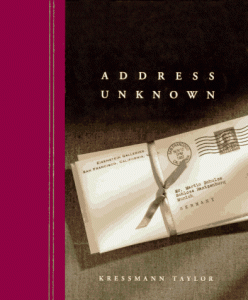 While I’m hunkered down reading THIS, I’ll quickly take a break to tell you about a very important little book. Address Unknown was thrust upon me by one of my favorite bookstore customers – an older Jewish man — insisting it was a vastly important classic. I looked down at the slim volume in my hands and wondered at his statement – how could this be a classic? That night not only did I devour it, I immediately turned back to the beginning and read it again. In the years since, it has a honored place on my bookshelf (right next to 84, Charing Cross Road) and I often pull it down to read it yet again and marvel at the author’s achievement within.
While I’m hunkered down reading THIS, I’ll quickly take a break to tell you about a very important little book. Address Unknown was thrust upon me by one of my favorite bookstore customers – an older Jewish man — insisting it was a vastly important classic. I looked down at the slim volume in my hands and wondered at his statement – how could this be a classic? That night not only did I devour it, I immediately turned back to the beginning and read it again. In the years since, it has a honored place on my bookshelf (right next to 84, Charing Cross Road) and I often pull it down to read it yet again and marvel at the author’s achievement within.
You may think I’ve lost it over here at Book Barmy, as this book is merely 54 pages long (eight of them blank), made up entirely of letters, and it comes with a New York Times hyperbolic blurb “This modern story is perfection itself. It is the most effective indictment of Nazism to appear in fiction.”
Address Unknown was first published in 1938 in Story magazine as a warning for Americans of the true nature of the Nazi menace, Reader’s Digest later reprinted the story and it went into its first world-wide book printing in 1939 — but was banned in Germany.
The book’s afterword, written by Taylor’s son, reveals that the idea for the story came from a small news article: American students visiting Germany wrote home about the Nazi atrocities. Fraternity brothers back in the U.S. thought it would be funny to send them letters making fun of Hitler, and the visiting students wrote back, “Stop it. We’re in danger. These people don’t fool around. You could murder [someone] by writing letters like this”. Thus emerged the idea of the “letter as a weapon”. Kressmann Taylor wanted to write about the truth of what was happening in Nazi Germany — a truth most Americans, including Charles Lindbergh, would not accept, mired in American isolationism.
The letters in Address Unknown span only 16 months and begin in 1932 as a fairly routine correspondence between art gallery owners – one having returned to Germany with his family — the other still in San Francisco holding down the gallery business. They are close friends, their families grew up together and there is much warmth in their early letters. But then the letters turn chilling and then downright menacing. What is most impressive about the construction of this storyline (other than its epistolary structure) is the weight of the time passing between the letters. These long silences say as much as the letters. The ending still makes me sit back and wonder whether what I am feeling is valid or disgusting. How often does that happen? This is the writing craft at its finest.
When Katherine Kressmann Taylor first submitted the story to her editor, he deemed it “too strong to appear under the name of a woman,” and published the work under the name Kressmann Taylor, dropping her first name. She used this name professionally for the rest of her life. Address Unknown was largely forgotten until 1995, when the book was republished to commemorate the 50th anniversary of the liberation of the concentration camps. At that time Kressmann was 91 and she happily spent her remaining years signing copies and giving interviews until her death at 93.
Address Unknown is readily available at your library or local independent bookstore.
The All Of It by Jeannette Haien
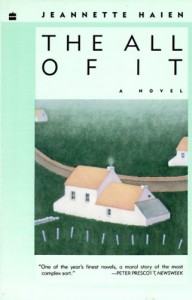 Lately I’ve been reading nothing but Kindle books and needed to feel a real book in my hands. I searched my shelves and found this little volume tucked behind another row of other books. (Oh come on, you do it too, double shelve your books for maximum space.) Anyway, I’d forgotten I had this book, had never read it and apparently purchased it back in 1988 when it was first published in paperback. “Well what ya know?” I muttered to myself.
Lately I’ve been reading nothing but Kindle books and needed to feel a real book in my hands. I searched my shelves and found this little volume tucked behind another row of other books. (Oh come on, you do it too, double shelve your books for maximum space.) Anyway, I’d forgotten I had this book, had never read it and apparently purchased it back in 1988 when it was first published in paperback. “Well what ya know?” I muttered to myself.
You see, Ann Patchett single-handedly brought The All Of It back from obscurity and into a new 2011 reprinting. She hand sells this title to customers at her bookstore, Parnassus Books and she raved about it during a NPR interview several years ago. I also remembered a writer friend, who doesn’t read much contemporary fiction had sung the praises of this small novella.
So I sat down to read, two hours later I closed the book and gazed about in a daze. I had been gone, transported by Ms. Haien’s magical writing. And, oh what writing — long sentences that flow flawlessly and dialogue so realistic you actually seem to hear the characters conversations.
Set in Ireland during early 1900’s, Father DeClan is at the bedside of a dying parishioner who is only able to make a partial confession before he dies. So it is left to his widow Enda to tell him “the all of it”.
“I appreciate, Enda, that it’ll be no easier for you to tell than for me to hear”, replies Father DeClan.
“You’ll need to be patient Father,” she qualified.
“I will of course, Enda”
And so it begins — and it’s a complex and beautiful story as Father DeClan’s religious beliefs face off with the hard realities of Enda’s tale of survival. At times both subtle and harsh, The All of It lays bare the complexity of choices made and the consequences of chances taken.
Enda’s tale of hardship and struggle is juxtaposed with Father DeClan salmon fishing on an Irish river bank during a cold and drenching rainstorm. These fishing scenes add another layer of nuance – is it meant to be a metaphor? You will have to decide for yourself, but I found the fishing descriptions allegorical as the Father struggles to fish in an unkind river while trying to understand Enda’s sin.
The characters are complex in this largely dialogue-driven narrative — even the dead husband comes alive during his full life. The Father’s struggles to re-arrange his beliefs, Enda’s lack of shame in her actions — all revealed through dialogue.
The ending is somewhat unresolved, which left me creating possibilities for an ending…mulling it over long after I finished reading. I urge you to find this book at your local bookstore or library and settle down with this short novella, revel in Ms. Haien’s writing and make up your own ending.
Small Blessings by Martha Woodroof
Small Blessings follows the intertwined lives of academics and their family members in a small Southern college town.
The above synopsis almost made me pass on this novel – sounded slightly mundane and I’m not a fan of academia novels.
Then, one Saturday morning, I heard Ms. Woodroof interviewed on NPR (she is a staff writer for NPR) and I warmed to her voice, attitude and that she’s a debut novelist at 67 years of age. (Approaching said decade myself, I seek any and all such bright, uplifting statistics, if you please)
I remembered I had Small Blessings on my Kindle and turned the first pages that evening — still convinced it would be a predictable read.
Yes, at first this is your average story: In a small, sleepy college town Tom Putnam, an English professor with a mentally troubled wife, is flatly going about his life when suddenly there is Rose, a lovely new employee of the campus bookstore. Tom and his wife are charmed by Rose and make plans for dinner.
Still thinking oh yes, a Lifetime movie plot is about to unwind, I carried on and wham! The story suddenly twists and turns. The characters become wholly unpredictable…and I found myself turning the pages and falling headlong into Ms. Woodroof’s atmospheric story.
Without giving away too much, Tom’s poor wife dies in an auto accident during the first few chapters, his mother-in-law, Agnes (my favorite character) becomes his ally. Tom falls a little bit more in love with Rose each day. At the same time, a past affair brings him Henry, a 10-year old boy, who may (or may not) be his son. Stir all this up with oddball (often drunk) supporting characters, a Southern town that knows everyone’s secrets, some melodrama and you’re in for a journey.
The campus atmosphere is beautifully rendered in an insulated Southern setting, but Ms. Woodroof also slyly lampoons the institution’s pretenses. The front lawns of the faculty housing are beautifully maintained for showing off to prospective students and parents, while the back yards grow weedy dependent on the faculty to tend – which they don’t.
I had my quibbles with Small Blessings. I found Tom Putnam to be almost catatonic in his passiveness, perhaps as an academic, he lives in his head – but at times I found it very irritating – especially in his marriage to Marjory: “Conscience was such a delicate balancing act. There was what he knew was right, what he ought to think was right, and what he wanted to do, all to be considered. It was the ultimate moral chess match, and it was the only game that mismatched married people got to play.”
The mental illness and death of Tom’s wife, Marjory are treated with a light, almost cavalier hand – as in this from Agnes, her mother: “Marjory is, I really do think, better off dead. I don’t know what dead is, of course, but it’s got to be more fun than my daughter’s life was.” and this later quote “the best thing she ever did in life was to give up on it. And that’s a bleak as a life can get.”
In the end, I found this an unpredictably candid and real storyline. Small Blessings teeters on the edge of soap-opera stereotype, but then surprises the reader with realism. The characters are flawed but ultimately loved. This is a story full of tragic events but it overflows with optimism. One of my favorite quotes: “When the going gets tough, the tough suck it up,” Agnes said. “The rest get run over.”
The outline of this novel screams “make me a TV movie!”, but if it is optioned, I hope they capture the story’s quirks and messiness.
Review copy provided by St. Martin’s Press via NetGalley.


